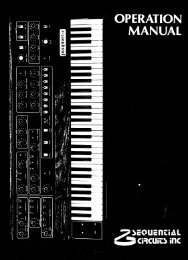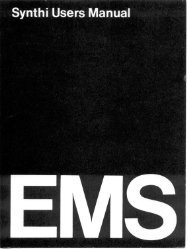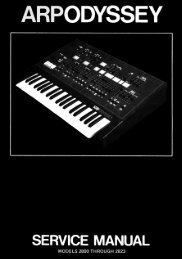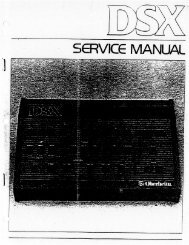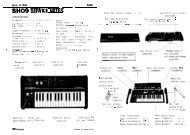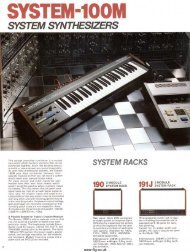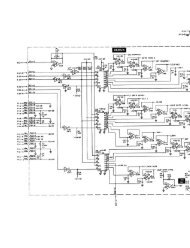SECTION10 S/H MODULEINTRODUCTIONThe sample-and-hold module is actually <strong>com</strong>posed <strong>of</strong> three discreet modules, each <strong>of</strong> which can beused on their own. It does make sense that they have been grouped together, however, since both thesample-and-hold module and the electronic switch are dependent upon the internal clock for operation.THE INTERNAL CLOCKThe internal clock is different from just about every other module on the 2600. It is almost never heard,nor was it intended to be heard. The internal clock performs a fairly simple task: It produces a constantstream <strong>of</strong> trigger pulses, one after the next+15vas shown in Figure 10-1. The drawing on thefront panel <strong>of</strong> the cabinet also depicts theseconstant trigger pulses, and can be seen in VoltsFigure 10-2.The internal clock has only one parameter,Timeand that is rate. Rate determines how quickly Figure 10-1: The trigger pulses output by the internal clockthe internal clock puts out pulses. The rate atwhich the internal clock puts out trigger pulses can be changed by moving the RATE slider shown inFigure 10-2 up or down. Again, this is the internal clock’s one and only parameter.THE INTERNAL CLOCK’S NORMALSThe internal clock is normalled to three other modules, butunlike the normals that have been examined to this point inthis text, one <strong>of</strong> these normals cannot be broken. First, theinternal clock is normalled to the sample-and-hold circuit. Thisconnection will be discussed in detail in a moment. Secondly,the internal clock is normalled to the electronic switch. Thisnormal cannot be broken. There are a few ways to work aroundthis problem which will be discussed later in this section. Finally,the internal clock is normalled to the envelope generators.This normal can be broken, but there are two ways to dothis, both <strong>of</strong> which will be discussed in a moment.Although it is not labeled to this effect, the EXT CLOCK IN Figure 10-2: The S/H Modulejack is where the clock is normalled to the sample-and-holdunit, and it is here that the internal clock’s normal to the sample-and-hold unit can be broken. A pulsewave connected here will trigger the sample-and-hold unit and cause it to sample. However, the in<strong>com</strong>ingpulse wave will not affect the electronic switch, because the internal clock cannot be controlled byan external device. This will be discussed in depth in a moment.075
076 - SECTION TEN: S/H MODULECLOCK IN, CLOCK OUTThere are two jacks associated with the internal clock, one <strong>of</strong> which is an input, and one <strong>of</strong> which is anoutput. A signal from another clock (or an oscillator) in the form <strong>of</strong> a pulse wave or trigger pulse can beconnected to the EXT CLOCK IN jack, and the normal between the internal clock and the sample-andholdunit is then broken. When an external trigger signal is connected to this jack, the in<strong>com</strong>ing signalwill replace the timing pulses to the sample-and-hold unit which was formerly controlled by the internalclock. However, the timing pulses just affect the sample-and-hold unit, since it is not possible tosynchronize the internal clock to an external source. The lines drawn on the front panel (see Figure 10-2 on page 75) seem to indicate that a signal connected to the EXT CLOCK IN jack would go to theclock and cause it to follow the in<strong>com</strong>ing source. Sadly, this is not the case. Thus, if one wants tosynchronize the internal clock and an external device, the internal clock must be allowed to control thetiming <strong>of</strong> the external device, since the external device can’t control the timing <strong>of</strong> the internal clock.The second jack associated with the clock is the clock output jack. One might think that since theinternal clock generates a series <strong>of</strong> trigger pulses that a series <strong>of</strong> trigger pulses would be output here.This is not the case, however. The internal clock actually drives a small oscillator which puts out asquare wave synchronized with the trigger pulses the clock produces. It is this square wave which isoutput at the INT CLOCK OUT jack. It is possible to connect this output to the mixer and hear a squarewave if the internal clock’s rate is set in the audio range, but since the frequency <strong>of</strong> the internal clock isnot voltage controllable, this is really not particularly useful for anything other than testing the module.S/H GATE SWITCHOne may recall that at the end <strong>of</strong> Section 7, a small switch and a corresponding jack were noted justbelow the EGs. To date, all <strong>of</strong> the experiments have made use <strong>of</strong> this switch in the upper position wherethe keyboard’s trigger and gate signals are normalled to the EGs and cause them to fire when a note isplayed. However, it is possible to use the internal clock to cause the EGs to fire. All one needs to do isto move the switch to the lower position. In the lower position, the keyboard’s trigger and gate normalsto the EGs are broken, and the internal clock is normalled to the EGs. It will send trigger pulses to themand cause them to fire at its specified rate. The internal clock’s normal to the EGs can thus be broken byreturning this switch to the upper position. This opens the door to many patches which seem to playthemselves, and are rather automatic in nature.The jack which is below this switch is indicated as being the normal from the “S/H Gate” which israther misleading. It seems that the 2600’s designers considered the electronic switch, the internalclock and the sample-and-hold units all part <strong>of</strong> the “Sample-and-Hold module.” Hence the label on thejack below the EG’s. However, it is really the internal clock which is responsible for causing the EGs t<strong>of</strong>ire, not the sample-and-hold unit.As one would expect, the normal from the internal clock to the EGs can be broken by inserting a pluginto the jack just below the switch. This will allow some marvelous possibilities later on when otherdevices are used to control the 2600. When this jack receives a gate type voltage from something suchas a pulse wave or an external clock, it will generate the appropriate gate and trigger signals to causethe EGs to fire.




